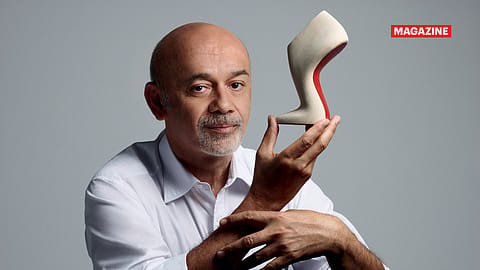India taught me that exuberance can be refined, says Christian Louboutin
Drawing inspiration from the nine hues of the Navratna (nine) gems, the iconic designer talks to Fortune India about his India-inspired collection La Vie en Inde, his infatuation with an exuberant India, and how beauty can be found in the most ordinary of things.

This story belongs to the Fortune India Magazine global-brands-indian-sheen issue.
CHRISTIAN LOUBOUTIN, who created the iconic red-soled shoes (quite by accident, in the early 1990s, experimenting with a move away from boring black), has always been fascinated with India, ever since his teenage years. Today, the global phenom (in India now, and since December 2023, in a joint venture partnership with Aditya Birla Fashion and Retail Ltd), is firmly entrenched in India’s high fashion circles, first teaming up with designer Sabyasachi Mukherjee in 2015, with a shoe line for his collection, followed by limited-edition capsules over the years.
What was it about India that has attracted you over the years?
I was fascinated by the idea that things don’t have to be minimal to be elegant. Growing up in France, elegance was often associated with simplicity. But India taught me that exuberance can be refined, that layers, colour, and ornamentation can have just as much sophistication. It started with imagery and imagination, and over the years, through travels, friendships, and deeper understanding, it became something much more personal. India continues to surprise and teach me and that’s what keeps the love alive.
You’ve had collections in the past, from being influenced by Rajasthan, to Kolkata, and now the Navratna. How is this collection different?
My love for India is in multiples of my collections. India is so detail-oriented that you can do an India-inspired collection for 100 years without repeating yourself! La Vie en Inde is a tribute to India’s enduring elegance and luminous spirit. Each piece in La Vie en Inde is imbued with the duality of refinement and festivity, offering creations for women and men that speak to modern elegance while remaining culturally rooted.
What is the focus of this collection? Will it be the gemstones — the different colours, or the properties of each gemstone — and how they translate upon your bags and shoes?
The focus of this collection isn’t the gemstones themselves in a literal sense— it’s the energy and emotion each one represents. In Indian tradition, each Navratna stone is associated with a planet, a force, a benefit whether it’s protection, clarity, vitality, or peace. That idea fascinated me. So rather than designing a shoe around a sapphire or a pearl, I asked myself: What does that stone feel like? What mood, glow, or intensity does it give? And then I translated that into colour, material, and silhouette. From the Diwadonna Flat (with a pointed toe and crystal-embellished mesh with a vibrant fabric in shades of pink, adorned with intricate patterns) to the Paloma Clutch (in delicate mesh and adorned with vibrant accents), every piece in La Vie en Inde is infused with this jewel-toned vocabulary — something joyful, luminous, and always elegant.
More Stories from this Issue
The name of the collection itself — La Vie en Inde — is almost like a play on the song La Vie en Rose — but of course with India. What is it about life in India that defines your aesthetic for this collection?
The name La Vie en Inde is definitely a nod to La Vie en Rose. But instead of seeing life through a romantic, pink-tinted lens, it is about seeing life through the lens of India, vivid, layered, intense, and deeply alive. What fascinates me about life in India is how it’s filled with meaning at every level; from the way people dress, to the rituals they follow, to the colours they live with. Beauty is everywhere, but it’s never passive, it has energy, it has purpose.
What is the biggest thing that you have learnt from India and its culture?
What India has taught me more than anything is to stay curious and humble. When I first started visiting, I thought I understood the country. But the more I returned, the more I realised how little I actually knew. That shift in perspective was important for me — both as a person and as a designer. India also taught me that beauty and meaning can be present in the most ordinary things. A piece of fabric, a flower, a gesture, nothing is just decorative. Everything has a story, a function, a deeper energy. In the western world, we often separate beauty from purpose. In India, they often exist together seamlessly. It’s a culture that doesn’t forget its roots, even while moving forward. That continuity between past and present is really amazing.
(INR CR)